Integrating Earth Observation with Stream Health and Agricultural Activity
Abstract
:1. Introduction

2. The Environment of This Study
3. Materials and Methods
3.1. Topography and Geology
3.2. Geophysical Analyses of Soil and Water
3.3. Remote Sensing and G.I.S
4. Results
5. Discussion
6. Conclusions
- -
- Specialised topographic analyses have always been part of environmental and agricultural studies, as topography is one of the most important factors affecting the aquatic environment and agriculture.
- -
- The combination of spectral induced polarisation (real and imaginary components) and magnetic susceptibility using remote sensing seems ideal for rapid and cost-effective environmental monitoring.
- -
- Agricultural land west of Heraklion is dominated by intra-parcel soil variability. It is strongly recommended that intra-parcel soil variability be considered prior to any agricultural activity to support the rational use of inputs (water, pesticides, and fertilisers) and further protect the aquatic environment.
- -
- Topographic attributes such as slope and aspect, imperviousness density, vegetation indices, soil apparent electrical conductivity, soil magnetic susceptibility, and the spectral induced polarisation response of water (real and imaginary components, phase) are robust indicators for a rapid and cost-effective environmental investigation of rural and suburban areas bordering streams before conducting specific analyses.
Author Contributions
Funding
Data Availability Statement
Acknowledgments
Conflicts of Interest
Appendix A
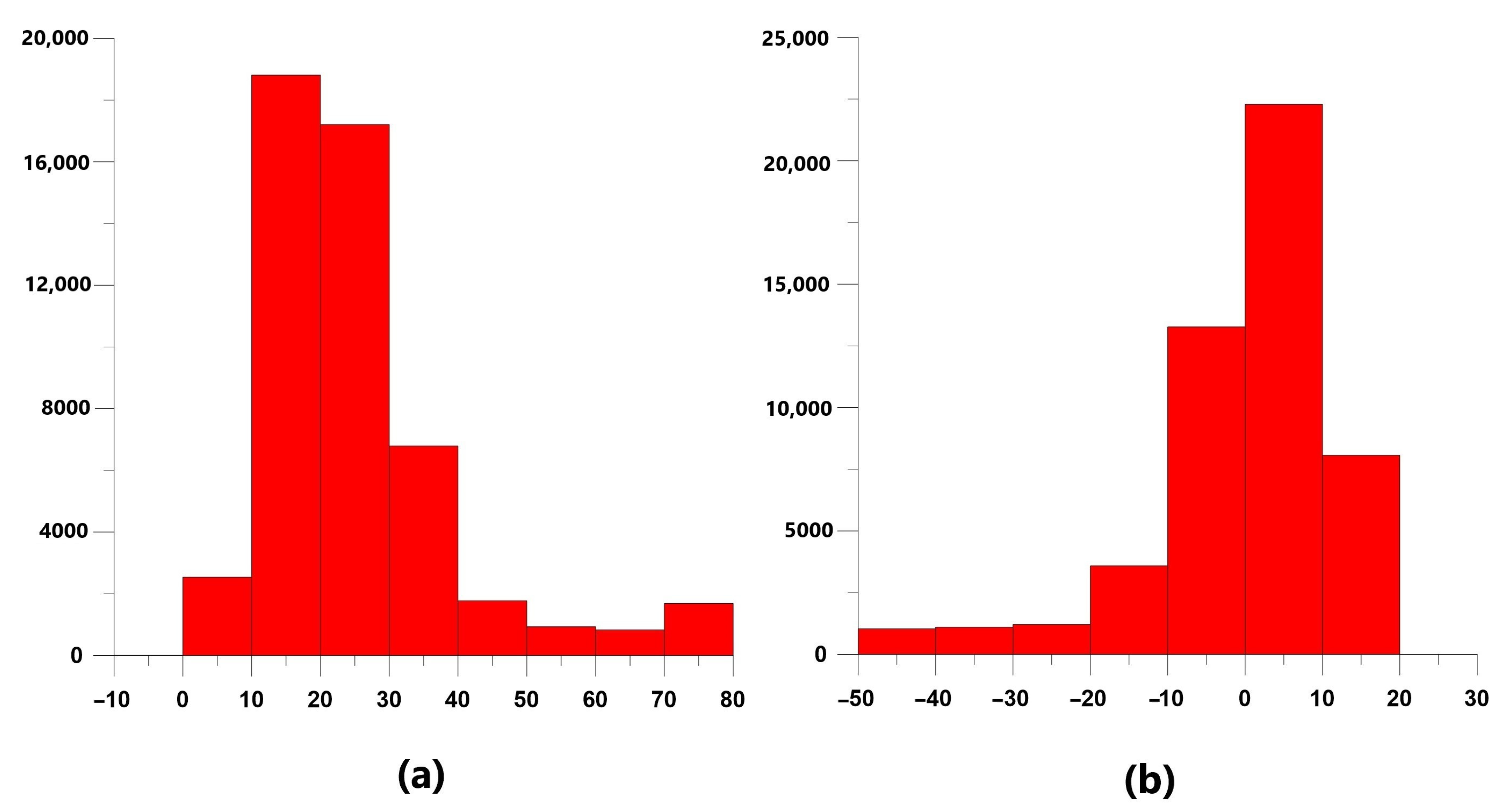
References
- Brazeau, S.; Ogden, N.H. Earth Observation, Public Health and One Health: Activities, Challenges and Opportunities; CABI: Wallingford, UK, 2022; pp. 1–106. [Google Scholar] [CrossRef]
- Neiderud, C.-J. How urbanization affects the epidemiology of emerging infectious diseases. Infect. Ecol. Epidemiol. 2015, 5, 1. [Google Scholar] [CrossRef]
- Jones, B.A.; Grace, D.; Kock, R.; Alonso, S.; Rushton, J.; Said, M.Y.; McKeever, D.; Mutua, F.; Young, J.; McDermott, J.; et al. Zoonosis emergence linked to agricultural intensification and environmental change. Proc. Natl. Acad. Sci. USA 2013, 110, 8399–8404. [Google Scholar] [CrossRef]
- Keesing, F.; Belden, L.K.; Daszak, P. Impacts of biodiversity on the emergence and transmission of infectious diseases. Nature 2010, 468, 647–652. [Google Scholar] [CrossRef]
- Ostfeld, R.S.; Keesing, F. Effects of host diversity on infectious disease. Annu. Rev. Ecol. Evol. Syst. 2012, 43, 157–182. [Google Scholar] [CrossRef]
- Altizer, S.; Ostfeld, R.S.; Johnson, P.T.; Kutz, S.; Harvell, C.D. Climate change and infectious diseases: From evidence to a predictive framework. Science 2013, 341, 514–519. [Google Scholar] [CrossRef] [PubMed]
- Oakley, A.L.; Collins, J.; Everson, L.; Heller, D.; Howerton, J.; Vincent, R. Riparian zones and freshwater wetlands. In Management of Wildlife and Fish Habitats in Forest of Western Oregon and Washington; US Department of Agriculture, Forest Service: Pacific Northwest Region, OR, USA, 1985; pp. 57–80. [Google Scholar]
- Odum, E.P. Ecological Importance of the Riparian Zone; General Technical Report WO-US; Department of Agriculture, Forest Service: Washington, DC, USA, 1979.
- Doufexi, M.; Gamvroula, D.E.; Alexakis, D.E. Elements’ Content in Stream Sediment and Wildfire Ash of Suburban Areas in West Attica (Greece). Water 2022, 14, 310. [Google Scholar] [CrossRef]
- Tha, T.; Piman, T.; Bhatpuria, D.; Ruangrassamee, P. Assessment of Riverbank Erosion Hotspots along the Mekong River in Cambodia Using Remote Sensing and Hazard Exposure Mapping. Water 2022, 14, 1981. [Google Scholar] [CrossRef]
- Wohl, E.; Castro, J.; Cluer, B.; Merritts, D.; Powers, P.; Staab, B.; Thorne, C. Rediscovering, Reevaluating, and Restoring Lost River-Wetland Corridors. Front. Earth Sci. 2021, 9, 511. [Google Scholar] [CrossRef]
- Barnett, Z.C.; Adams, S.B. Review of Dam Effects on Native and Invasive Crayfishes Illustrates Complex Choices for Conservation Planning. Front. Ecol. Evol. 2021, 8, 621723. [Google Scholar] [CrossRef]
- Wymore, A.S.; Ward, A.S.; Wohl, E.; Harvey, J.W. Viewing river corridors through the lens of critical zone science. Front. Water 2023, 5, 1147561. [Google Scholar] [CrossRef]
- Harvey, J.; Gooseff, M. River corridor science: Hydrologic exchange and ecological consequences from bedforms to basins. Water Resour. Res. 2015, 50, 6893–6922. [Google Scholar] [CrossRef]
- Van der Werf, H.M.G. Assessing the impact of pesticides on the environment. Agric. Ecosyst. Environ. 1996, 60, 81–96. [Google Scholar] [CrossRef]
- Reichenberger, S.; Bach, M.; Skitschak, A.; Frede, H.G. Mitigation strategies to reduce pesticide inputs into the ground- and surface water and their effectiveness. A review. Sci. Total Environ. 2007, 384, 1–35. [Google Scholar] [CrossRef] [PubMed]
- Directive 2009/128/EC of the European Parliament and of the Council of 21 October 2009 establishing a framework for Community action to achieve the sustainable use of pesticides. Off. J. Eur. Union 2009, L 309, 71–86.
- Navarro, S.; Vela, N.; Navarro, G. An overview on the environmental behaviour of pesticide residues in soils. Span. J. Agric. Res. 2007, 5, 357–375. [Google Scholar] [CrossRef]
- Kordel, W.; Klein, M. Prediction of leaching and groundwater contamination by pesticides. Pure Appl. Chem. 2006, 78, 1081–1090. [Google Scholar] [CrossRef]
- Tank, J.L.; Speir, S.L.; Sethna, L.R.; Royer, T.V. The Case for Studying Highly Modified Agricultural Streams: Farming for Biogeochemical Insights. Limnol. Oceanogr. Bull. 2021, 30, 41–47. [Google Scholar] [CrossRef]
- Blann, K.L.; Anderson, J.L.; Sands, G.R.; Vondracek, B. Effects of agricultural drainage on aquatic ecosystems: A review. Crit. Rev. Environ. Sci. Technol. 2009, 39, 909–1001. [Google Scholar] [CrossRef]
- Diaz, R.J.; Rosenberg, R. Spreading dead zones and consequences for marine ecosystems. Science 2008, 321, 926–929. [Google Scholar] [CrossRef]
- Sarris, A.; Kokinou, E.; Aidona, E.; Kallithrakas-Kontos, N.; Koulouridakis, P.; Kakoulaki, G.; Droulia, K.; Damianovits, O. Environmental study for pollution in the area of the Megalopoli power plant (Peloponnesus, Greece). Environ. Geol. 2009, 58, 1769–1783. [Google Scholar] [CrossRef]
- Kokinou, E.; Belonaki, C.; Sakadakis, D.; Sakadaki, K. Environmental monitoring of soil pollution in urban areas (a case study from Heraklion city, Central Crete, Greece). Bull. Geol. Soc. Greece 2013, 47, 963–971. [Google Scholar] [CrossRef]
- Kokinou, E.; Zacharioudaki, D.; Kokolakis, S.; Kotti, M.; Chatzidavid, D.; Karagiannidou, M.; Fanouraki, E.; Kontaxakis, E. Spatiotemporal environmental monitoring of the karst-related Almyros Wetland (Heraklion, Crete, Greece, Eastern Mediterranean). Environ. Monit. Assess. 2023, 195, 955. [Google Scholar] [CrossRef] [PubMed]
- Briassoulis, H. Crete: Endowed by Nature, Privileged by Geography, Threatened by Tourism? J. Sustain. Tour. 2003, 11, 97–115. [Google Scholar] [CrossRef]
- Barboutis, C.; Navarrete, E.; Karris, G.; Xirouchakis, S.; Fransson, T.; Bounas, A. Arriving depleted after crossing of the Mediterranean: Obligatory stopover patterns underline the importance of Mediterranean islands for migrating birds. Anim. Migr. 2022, 9, 14–23. [Google Scholar] [CrossRef]
- Vidakis, Μ.; Meulenkamp, J.E.; Koutsouveli, A.; Ioakim, C.; Papazeti, E.; Skourtsi-Koronaiou, V. Geological Map of Greece in 1:50,000 scale—Heraklion Sheet. IGME Athens 1996. [Google Scholar]
- Roberts, G.G.; White, N.J.; Shaw, B. An uplift history of Crete, Greece, from inverse modeling of longitudinal river profiles. Geomorphology 2013, 198, 177–188. [Google Scholar] [CrossRef]
- Strahler, A.N. Quantitative analysis of watershed geomorphology. Trans. Am. Geophys. Union 1957, 38, 913–920. [Google Scholar]
- Rackham, O.; Moody, J. The Making of the Cretan Landscape; Manchester University Press: Manchester, UK, 1996. [Google Scholar]
- Vogiatzakis, I.; Mannion, A.M.; Pungetti, G. Introduction to the Mediterranean Island Landscapes. In Mediterranean Island Landscapes; Landscape Series; Vogiatzakis, I., Pungetti, G., Mannion, A.M., Eds.; Springer: Dordrecht, The Netherlands, 2008; Volume 9. [Google Scholar] [CrossRef]
- Kokinou, E.; Skilodimou, H.D.; Bathrellos, G.D.; Antonarakou, A.; Kamberis, E. Morphotectonic analysis, structural evolution/pattern of a contractional ridge: Giouchtas Mt., Central Crete, Greece. J. Earth Syst. Sci. 2015, 124, 587–602. [Google Scholar]
- Kokinou, E. Magnetic properties of soils in a designated Natura area (GR4310010, Giouchtas Mountain). SEG Interpret. 2015, 3, SAB33–SAB42. [Google Scholar] [CrossRef]
- Ministry of Environment & Energy—Department of Energy. Preparation of the 1st Revision of the River Basin Management Plan of the Republic of Crete (EL 13), Intermediate Phase: 2. Deliverable 18; Strategic Environmental Impact Assessment (SEA): Athens, Greece, 2017. [Google Scholar]
- Panagiotakis, C.; Kokinou, E. Linear Pattern Detection of Geological Faults via a Topology and Shape Optimization Method. IEEE J. Sel. Top. Appl. Earth Obs. Remote Sens. 2015, 8, 3–11. [Google Scholar] [CrossRef]
- Toulia, E.; Kokinou, E.; Panagiotakis, C. The contribution of pattern recognition techniques in geomorphology and geology: The case study of Tinos Island (Cyclades, Aegean, Greece). Eur. J. Remote Sens. 2018, 51, 88–99. [Google Scholar] [CrossRef]
- Kokinou, E.; Panagiotakis, C. Structural pattern recognition applied on bathymetric data from the Eratosthenes Seamount (Eastern Mediterranean, Levantine Basin). Geo-Mar. Lett. 2018, 38, 527–540. [Google Scholar] [CrossRef]
- Kokinou, E.; Panagiotakis, C. Automatic Pattern Recognition of Tectonic Lineaments in Seafloor Morphology to Contribute in the Structural Analysis of Potentially Hydrocarbon-Rich Areas. Remote Sens. 2020, 12, 1538. Available online: https://www.mdpi.com/2072-4292/12/10/1538 (accessed on 15 April 2023). [CrossRef]
- Kokinou, E. Automatic pattern recognition and GPS/GNSS technology in marine digital terrain model. In GPS and GNSS Technology in Geosciences; Petropoulos, G., Srivastava, P., Eds.; Elsevier: Amsterdam, The Netherlands, 2021; pp. 241–254. Available online: https://www.sciencedirect.com/science/article/pii/B9780128186176000196 (accessed on 15 April 2023).
- Kasapaki, A. Spatial Distribution of the Magnetic Susceptibility along the Drainage Network of Karteros in Heraklion Crete. Bachelor’s Thesis, Hellenic Mediterranean University, Chania, Greece, 2009. Available online: http://hdl.handle.net/11713/2574 (accessed on 29 April 2023).
- Scholger, R. Heavy metal pollution monitoring by magnetic susceptibility measurements applied to sediments of the river Mur (Styria, Austria). Eur. J. Envirn. Eng. Geophys. 1998, 3, 25–37. [Google Scholar]
- Bityukova, L.; Scholger, R.; Birke, M. Magnetic susceptibility as indicator of environmental pollution of soils in Tallinn (Estonia). Phys. Chem. Earth 1999, 24, 829–835. [Google Scholar] [CrossRef]
- Petrovsky, E.; Kapička, A.; Jordanova, N.; Borůvka, L. Magnetic properties of alluvial soils contaminated with lead, zinc and cadmium. J. Appl. Geophys. 2001, 48, 127–136. [Google Scholar] [CrossRef]
- Boyko, T.; Scholger, R.; Stanjek, H.; MAGPROX Team. Topsoil magnetic susceptibility mapping as a tool for pollution monitoring: Repeatability of in situ measurements. J. Appl. Geophys. 2004, 55, 249–259. [Google Scholar] [CrossRef]
- Thompson, T.; Oldfield, F. (Eds.) Environmental Magnetism; Allen and Unwin: London, UK, 1986. [Google Scholar]
- Kokinou, E.; Papadopoulos, I.; Vallianatos, F. A geophysical survey on marls of Heraklion city in Crete Island (Southern Hellenic Arc, Greece). In Proceedings of the 2nd International Conference on Engineering Mechanics, Structures, Engineering Geology (EMESEG ’09), Rhodes Island, Greece, 22–24 July 2009; pp. 202–207, ISBN 978-960-474-101-4. [Google Scholar]
- Savvaidis, A.; Margaris, B.; Theodoulidis, N.; Lekidis, V.; Karakostas, C.; Loupasakis, C.; Rozos, D.; Soupios, P.; Mangriotis, M.-D.; Dikmen, U.; et al. Geo-Characterization at selected accelerometric stations in Crete (Greece) and comparison of earthquake data recordings with EC8 elastic spectra. Cent. Eur. J. Geosci. 2014, 6, 88–103. [Google Scholar] [CrossRef]
- Atekwana, E.A.; Slater, L.D. Biogeophysics: A new frontier in Earth science research. Rev. Geophys. 2009, 47, RG4004. [Google Scholar] [CrossRef]
- Revil, A.; Karaoulis, M.; Johnson, T.; Kemna, A. Review: Some low-frequency electrical methods for subsurface characterization and monitoring in hydrogeology. Hydrogeol. J. 2012, 20, 617–658. [Google Scholar] [CrossRef]
- Kemna, A.; Binley, A.; Cassiani, G.; Niederleithinger, E.; Revil, A.; Slater, L.; Williams, K.H.; Orozco, A.F.; Haegel, F.H.; Hördt, A.; et al. An overview of the spectral induced polarization method for near-surface applications. Near Surf. Geophys. 2012, 10, 453–468. [Google Scholar] [CrossRef]
- Kirmizakis, P.; Kalderis, D.; Ntarlagiannis, D.; Soupios, P. Preliminary assessment on the application of biochar and spectral induced polarization for wastewater treatment. Near Surf. Geophys. 2020, 18, 109–122. [Google Scholar] [CrossRef]
- Slater, L.D.; Lesmes, D. IP interpretation in environmental investigations. Geophysics 2002, 67, 77–88. [Google Scholar] [CrossRef]
- Binley, A.; Kemna, A. DC Resistivity and Induced Polarization Methods. Hydrogeophysics 2005, 50, 129–156. [Google Scholar]
- Kumhálová, J.; Kumhála, F.; Kroulík, M. The impact of topography on soil properties and yield and the effects of weather conditions. Precis. Agric. 2011, 12, 813–830. [Google Scholar] [CrossRef]
- Bakhsh, A.; Colvin, T.S.; Jaynes, D.B.; Kanwar, R.S.; Tim, U.S. Using soil attributes and GIS for interpretation of spatial variability in yield. Trans. ASABE 2000, 43, 819–828. [Google Scholar] [CrossRef]
- Kravchenko, A.N.; Bullock, D.G. Correlation of corn and soybean grain yield with topography and soil properties. J. Agron. 2000, 92, 75–83. [Google Scholar] [CrossRef]
- Kravchenko, A.N.; Bullock, D.G. Spatial variability of soybean quality data as a function of field topography: I, spatial data analysis. Crop. Sci. 2002, 42, 804–815. [Google Scholar] [CrossRef]
- Jenson, S.K.; Domingue, J.O. Extracting topographic structure from digital elevation data for geographic information system analysis. Photogramm. Eng. Remote Sens. 1988, 54, 1593–1600. Available online: https://pubs.usgs.gov/publication/70142175 (accessed on 25 May 2023).
- Agnoli, L.; Urquhart, E.; Georgantzis, N.; Schaeffer, B.; Simmons, R.; Hoque, B.; Neely, M.B.; Neil, C.; Oliver, J.; Tyler, A. Perspectives on user engagement of satellite Earth observation for water quality management. Technol. Forecast. Soc. Chang. 2023, 189, 122357. [Google Scholar] [CrossRef]
- Ferreira, B.; Iten, M.; Silva, R.G. Monitoring sustainable development by means of Earth observation data and machine learning: A review. Environ. Sci Eur. 2020, 32, 120. [Google Scholar] [CrossRef]
- Pasher, J.; Smith, P.A.; Forbes, M.R.; Duffe, J. Terrestrial ecosystem monitoring in Canada and the greater role for integrated Earth observation. Environ. Rev. 2014, 22, 179–187. [Google Scholar] [CrossRef]
- Ramirez-Reyes, C.; Brauman, K.A.; Chaplin-Kramer, R.; Galford, G.L.; Adamo, S.B.; Anderson, C.B.; Anderson, C.; Allington, G.R.H.; Bagstad, K.J.; Coe, M.T.; et al. Reimagining the potential of Earth observations for ecosystem service assessments. Sci. Total Environ. 2019, 665, 1053–1063. [Google Scholar] [CrossRef] [PubMed]
- Crocetti, L.; Forkel, M.; Fischer, M.; Jurečka, F.; Grlj, A.; Salentinig, A.; Trnka, M.; Anderson, M.; Ng, W.-T.; Kokalj, Ž.; et al. Earth observation for agricultural drought monitoring in the Pannonian Basin (Southeastern Europe): Current state and future directions. Reg. Environ. Chang. 2020, 20, 123. [Google Scholar] [CrossRef]
- Lawford, R.; Strauch, A.; Toll, D.; Fekete, B.; Cripe, D. Earth observations for global water security. Curr. Opin. Environ. Sustain. 2013, 5, 633–643. [Google Scholar] [CrossRef]
- Uereyen, S.; Kuenzer, C. A review of Earth observation-based analyses for major river basins. Remote Sens. 2019, 11, 2951. [Google Scholar] [CrossRef]
- Romero-Ruiz, A.; Linde, N.; Keller, T.; Or, D. A Review of Geophysical Methods for Soil Structure Characterization. Rev. Geophys. 2018, 56, 672–697. [Google Scholar] [CrossRef]
- Samouelian, A.; Cousin, I.; Tabbagh, A.; Bruand, A.; Richard, G. Electrical resistivity survey in soil science: A review. Soil Tillage Res. 2005, 83, 173–193. [Google Scholar] [CrossRef]
- Allred, B.J.; Daniels, J.J.; Ehsani, M.R. Handbook of Agricultural Geophysics; CRC Press: Boca Raton, FL, USA, 2008. [Google Scholar]
- Kritikakis, G.; Kokinou, E.; Economou, N.; Andronikidis, N.; Brintakis, J.; Daliakopoulos, I.N.; Kourgialas, N.; Pavlaki, A.; Fasarakis, G.; Markakis, N.; et al. Estimating Soil Clay Content Using an Agrogeophysical and Agrogeological Approach: A Case Study in Chania Plain, Greece. Water 2022, 14, 2625. [Google Scholar] [CrossRef]
- Grimm, N.B.; Faeth, S.H.; Golubiewski, N.E.; Redman, C.L.; Wu, J.; Bai, X.; Briggs, J.M. Global change and the ecology of cities. Science 2008, 319, 756–760. [Google Scholar] [CrossRef]
- Haase, D. Reflections about blue ecosystem services in cities. Sustain. Water Qual. Ecol. 2015, 5, 77–83. [Google Scholar] [CrossRef]
- Elmqvist, T.; Setälä, H.; Handel, S.N.; van der Ploegn, S.; Aronson, J.; Blignaut, J.N.; Gómez-Baggethun, E.; Nowak, D.J.; Kronenberg, J.; de Groot, R. Benefits of restoring ecosystem services in urban areas. Curr. Opin. Environ. Sustain. 2015, 14, 101–108. [Google Scholar] [CrossRef]
- Calapez, A.R.; Serra, S.R.Q.; Mortágua, A.; Almeida, S.F.P.; João Feio, M. Unveiling relationships between ecosystem services and aquatic communities in urban streams. Ecol. Indic. 2023, 153, 110433. [Google Scholar] [CrossRef]
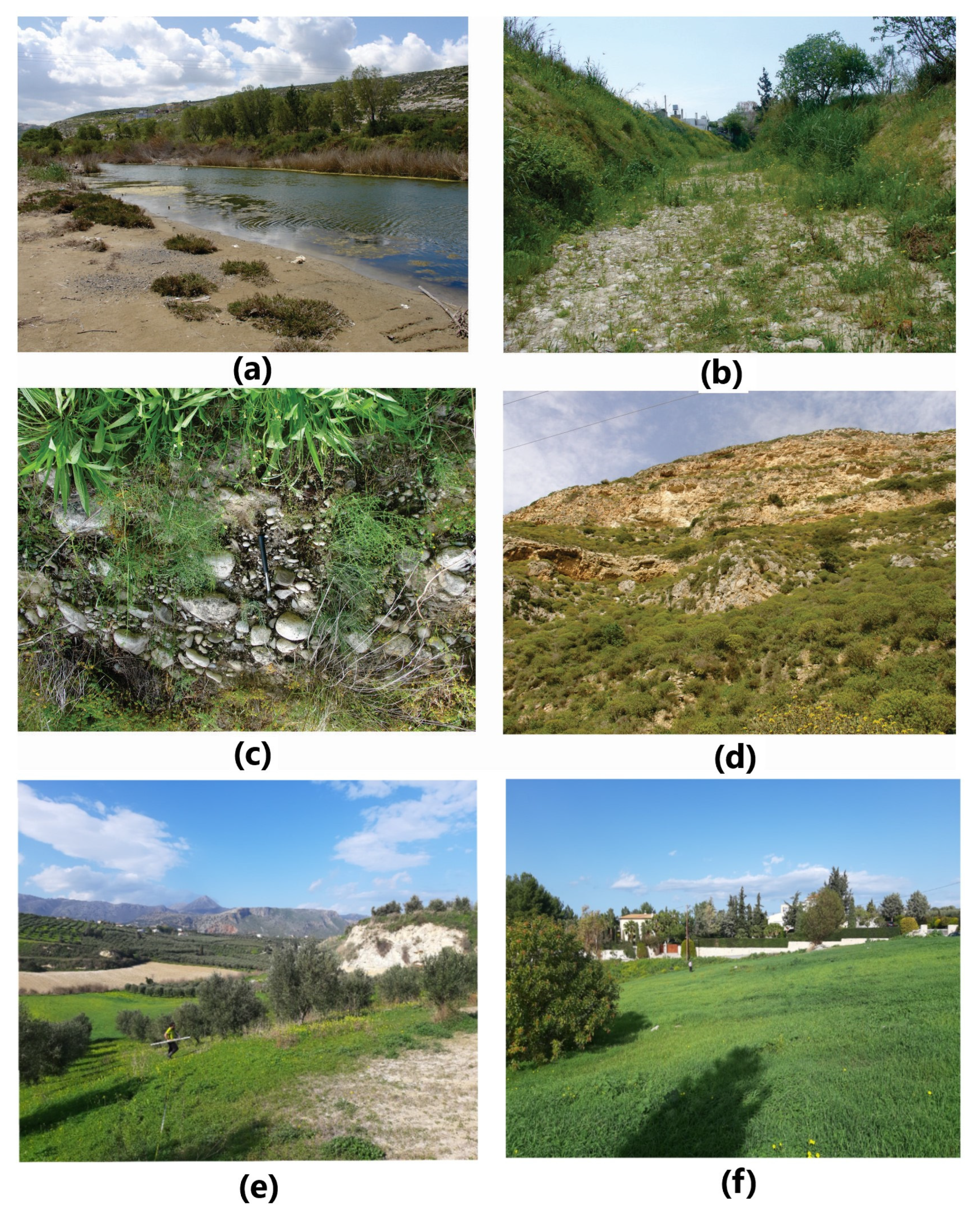
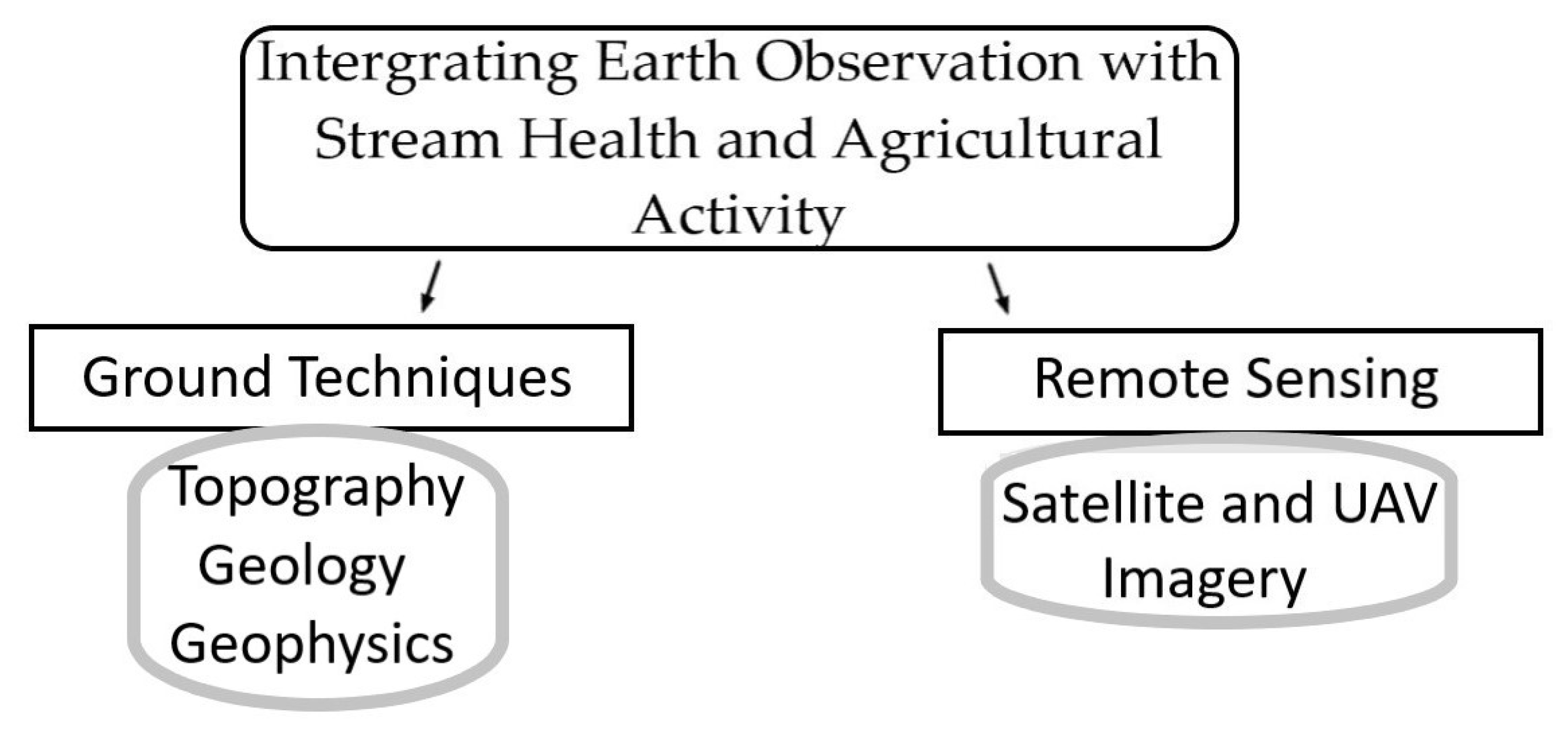
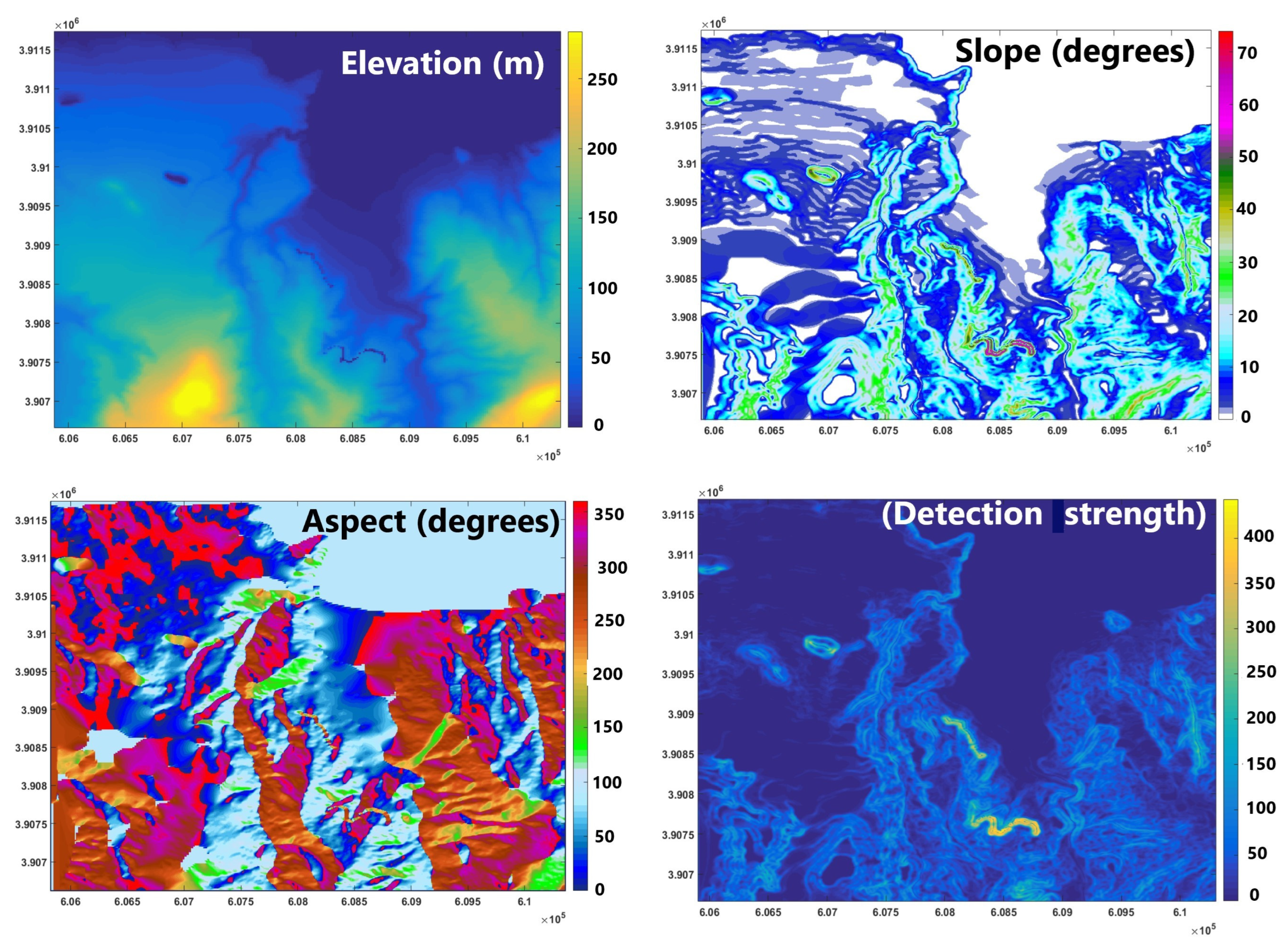

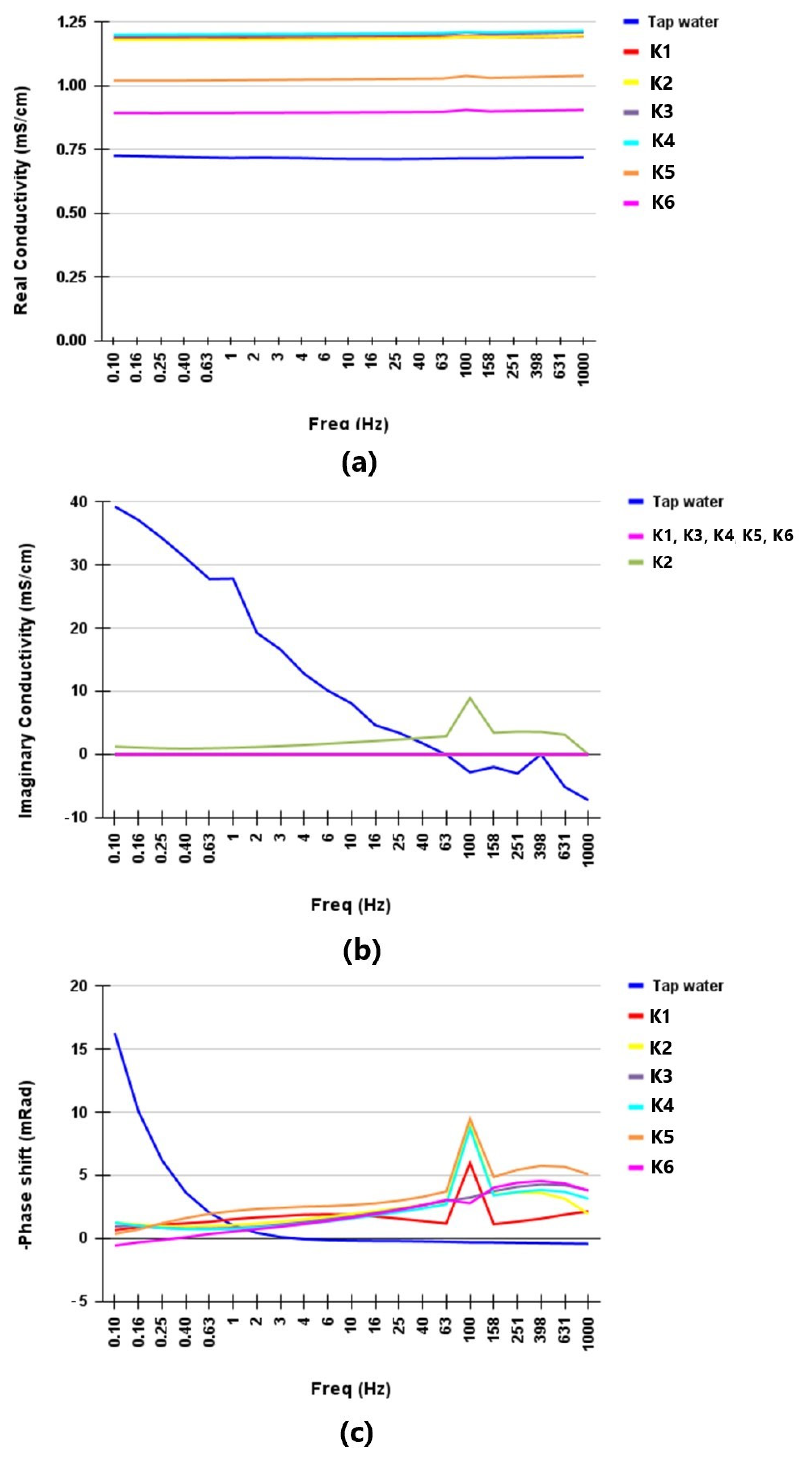


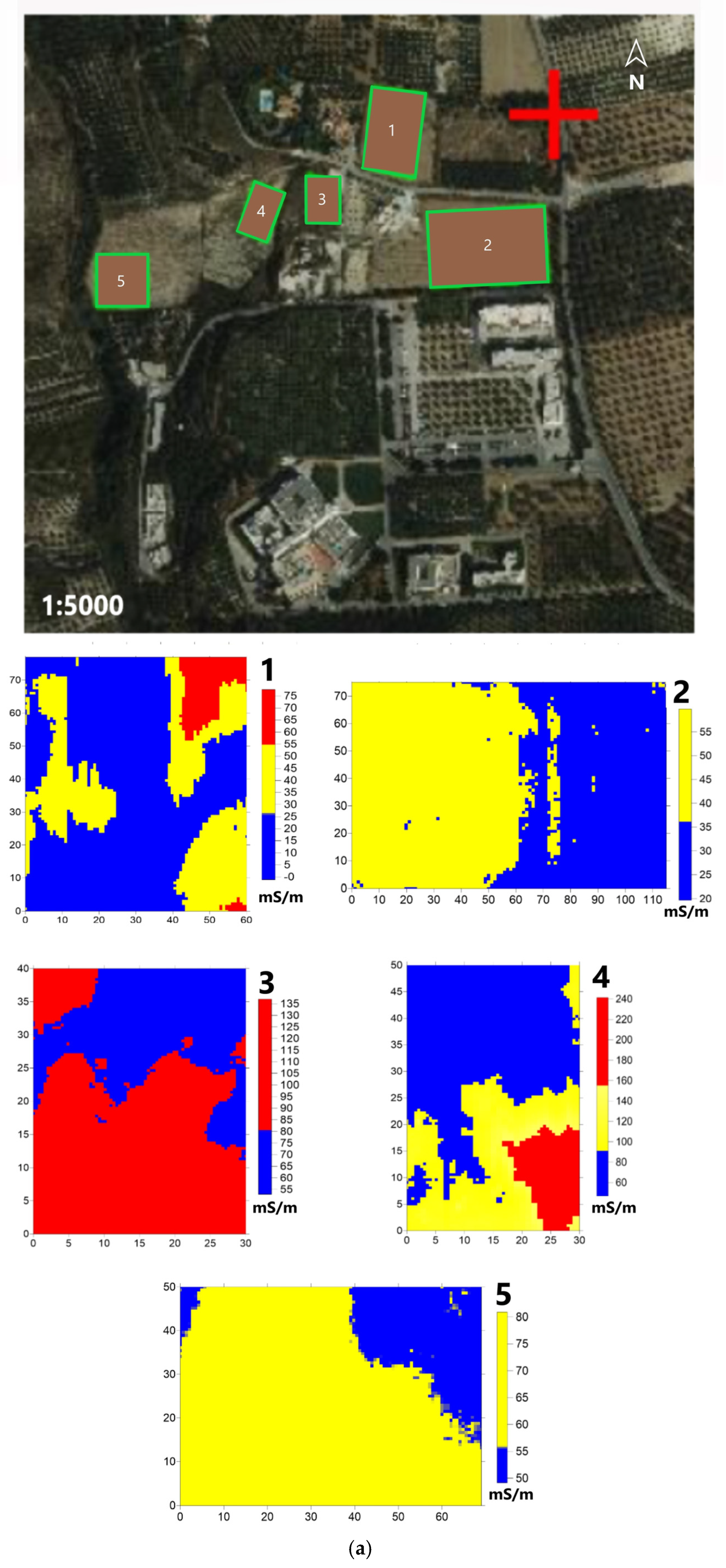

| Formation | Thickness (m) | Seismic Velocity (km/s) | Resistivity (Ohm.m) | Low-Frequency (Flow = 0.43 KHz) Background Magnetic Susceptibility (SI Units) |
|---|---|---|---|---|
| Holocene—Fluvial and closed basin deposits (al) | Up to 25 | 0.7–1 | 15–30 | ~16.5 |
| Holocene—Marine terraces and coastal sands (Pt.m) | 2–4 | 0.2–0.3 | >20 | ~15.2 |
| Lower–Middle Pliocene—Finikia formation (Pl.m) | >150 | ~1.4 | 20–150 | ~18 |
| Upper Miocene—Ag. Varvara formation (M.k, M.m) | ~280 | 1.4–1.8 | 250–500 | Not measured |
| Upper Triassic–Upper Jurassic Limestones (Ts-Js.Kd) | Up to 300 | 5.4–5.8 | 2000–2500 | Not measured |
Disclaimer/Publisher’s Note: The statements, opinions and data contained in all publications are solely those of the individual author(s) and contributor(s) and not of MDPI and/or the editor(s). MDPI and/or the editor(s) disclaim responsibility for any injury to people or property resulting from any ideas, methods, instructions or products referred to in the content. |
© 2023 by the authors. Licensee MDPI, Basel, Switzerland. This article is an open access article distributed under the terms and conditions of the Creative Commons Attribution (CC BY) license (https://creativecommons.org/licenses/by/4.0/).
Share and Cite
Chatzidavid, D.; Kokinou, E.; Kokolakis, S.; Karagiannidou, M. Integrating Earth Observation with Stream Health and Agricultural Activity. Remote Sens. 2023, 15, 5485. https://doi.org/10.3390/rs15235485
Chatzidavid D, Kokinou E, Kokolakis S, Karagiannidou M. Integrating Earth Observation with Stream Health and Agricultural Activity. Remote Sensing. 2023; 15(23):5485. https://doi.org/10.3390/rs15235485
Chicago/Turabian StyleChatzidavid, David, Eleni Kokinou, Stratos Kokolakis, and Matina Karagiannidou. 2023. "Integrating Earth Observation with Stream Health and Agricultural Activity" Remote Sensing 15, no. 23: 5485. https://doi.org/10.3390/rs15235485






